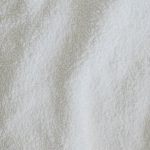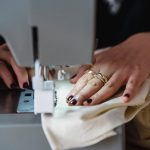Are you tired of straining your eyes while working on your sewing projects? Having the right lighting is crucial when it comes to sewing, as it can greatly impact the quality and accuracy of your work. The right lighting can help reduce eye strain, improve visibility, and enhance your overall sewing experience.
There are several types of lighting options available, each with their own advantages and disadvantages. From natural daylight to artificial lighting, it’s important to choose the best option for your sewing environment.
In this article, we’ll explore the importance of good lighting for sewing projects, the different types of lighting options available, and factors to consider when choosing the best lighting for your sewing needs.
Table of Contents
Importance of Good Lighting for Sewing Projects
Good lighting is crucial when it comes to sewing; without it, you may find yourself squinting at your fabric or struggling to see your stitches clearly. Sewing requires attention to detail and precision, and good lighting ensures that you can see every thread and stitch.
It’s important to have enough light to illuminate your work area without creating harsh shadows or glare. Having proper lighting can also help reduce eye strain and prevent headaches from prolonged sewing sessions. When you strain your eyes to see your work, you run the risk of developing eye fatigue, which can lead to headaches and even vision problems.
By investing in good lighting, you can alleviate eye strain and make your sewing experience more comfortable. In addition to improving the quality of your work and preventing eye strain, good lighting can also enhance your overall sewing experience. By being able to clearly see your work, you’ll feel more confident and in control of your project.
Plus, with the right lighting, you can create a cozy and inviting atmosphere in your sewing space, making it a place where you’ll want to spend more time.
Types of Lighting Options
If you’re looking for the right lighting for your sewing projects, there are a few types of lighting options to consider.
Overhead lighting provides general illumination, but task lighting is more focused and can help reduce eye strain.
If you prefer natural light, there are lamps designed to mimic daylight.
And if you need to see small details more clearly, a magnifying lamp may be the best option for you.
Overhead Lighting
To achieve optimal lighting for your sewing projects, you should position overhead lighting directly above your workspace. This type of lighting provides a wide and even illumination that minimizes shadows and eye strain.
Overhead lighting can be achieved through ceiling-mounted fixtures, track lighting, or pendant lights. When choosing overhead lighting for your sewing area, consider the color temperature of the bulbs. A cool white or daylight bulb will provide the most accurate color rendering, which is important when working with fabrics and thread.
Additionally, make sure the lighting is bright enough to see fine details but not so bright that it causes glare or discomfort. With the right overhead lighting in place, you can sew with ease and precision.
Task Lighting
One way to improve your sewing experience is by incorporating task lighting, which can be positioned directly over your work area to provide focused illumination and reduce eye strain. Task lighting is typically a smaller light source than overhead lighting and can be adjusted to shine directly on the specific area you’re working on.
This makes it easier to see the intricate details of your sewing project and reduces the strain on your eyes. When choosing task lighting for your sewing area, consider the brightness and color temperature of the light. A bright, cool-toned light can help make your work area more visible and help you see the true colors of your fabric.
On the other hand, a warmer-toned light can create a cozy and inviting sewing space. Task lighting can come in a variety of forms, including clip-on lamps, floor lamps, and even sewing machine lights. Experiment with different options to find the best fit for your sewing needs.
Natural Daylight Lamps
You’ll love the natural daylight lamps for your sewing area, as they mimic the brightness and color temperature of sunlight, making it easier to see your fabric and reduce eye strain.
These lamps are designed to provide full-spectrum lighting, which means that they emit a wide range of colors that are similar to natural daylight. This type of lighting is perfect for sewing because it allows you to see your fabric in its true colors, making it easier to match threads and fabrics.
Natural daylight lamps also help to reduce eye strain, which can be a common problem for sewers who spend long hours working on their projects. By providing bright, clear lighting, these lamps help to reduce the amount of strain on your eyes, which can help to prevent headaches and other eye-related problems.
So, if you want to create a comfortable and productive sewing environment, consider investing in a natural daylight lamp for your workspace.
Magnifying Lamps
Magnifying lamps are an important tool for sewers who want to ensure accuracy and precision in their work. These lamps allow you to see details that may be difficult to spot with the naked eye, making it easier to sew intricate patterns and work with small pieces of fabric.
Here are some benefits of using magnifying lamps for sewing:
-
Improved visibility: Magnifying lamps come with built-in magnifying lenses that can help you see details up close. This can be especially helpful when working with dark fabrics or small pieces of fabric.
-
Reduced eye strain: Sewing for long periods of time can cause eye strain and fatigue. Magnifying lamps reduce the strain on your eyes by magnifying the details you need to see, which means you don’t have to squint or strain to see them.
-
Better accuracy: When you can see the details more clearly, you can sew with greater accuracy. This means fewer mistakes and a more professional-looking finished product.
Overall, magnifying lamps are a great investment for any sewer who wants to take their skills to the next level. With the improved visibility, reduced eye strain, and greater accuracy they provide, you’ll be able to sew with confidence and precision.
Factors to Consider When Choosing Lighting
When choosing lighting for sewing, it’s crucial to take into account the brightness and positioning of the light source, as well as the color temperature of the light. A well-lit workspace can help reduce eye strain, improve accuracy and prevent mistakes. Here are some factors to consider when choosing lighting for your sewing area:
Firstly, the brightness of the light source is important. You want to make sure the light is bright enough to see your work clearly but not so bright that it causes glare or shadows. The ideal brightness will depend on the size of your workspace and the type of sewing you’re doing. Positioning the light source is also important. You want to make sure the light is directed at your work surface and not shining directly into your eyes.
Secondly, the color temperature of the light can impact the colors of the fabric you’re working with. A light that’s too warm (yellow/orange) can make white fabrics look yellow, while a light that’s too cool (blue) can make white fabrics look blue. A light with a neutral color temperature (between 4000-5000K) is ideal for sewing.
Lastly, consider the type of lighting fixture you want to use. Table lamps, floor lamps, and overhead lighting are all options. Table lamps and floor lamps are ideal for directing light exactly where you need it, while overhead lighting can provide more general lighting for your sewing area. Consider using a combination of different lighting fixtures to create the perfect lighting setup for your needs.
| Brightness | Color Temperature | Lighting Fixture |
|---|---|---|
| Bright enough to see clearly | Neutral (4000-5000K) | Table lamps or floor lamps for directed light, overhead lighting for general light |
| Not too bright to cause glare or shadows | A combination of different fixtures for optimal lighting | |
| Dependent on workspace and sewing type |
Best Lighting Options for Different Sewing Environments
Now that you know the factors to consider when choosing lighting for your sewing space, let’s dive into the best lighting options for different sewing environments. Depending on where you sew, you may need different types of lighting to optimize your visibility and comfort.
If you sew in a well-lit room with plenty of natural light, you may only need a few additional light sources to enhance your visibility. Desk lamps or floor lamps with adjustable arms can be helpful for casting light exactly where you need it. Additionally, consider using daylight bulbs with a color temperature of 5000K or higher to mimic natural daylight and reduce eye strain.
On the other hand, if you sew in a dimly lit basement or garage, you’ll need to invest in brighter and more focused lighting options. Overhead track lighting or ceiling-mounted fixtures can provide ample light for your sewing space. You may also want to consider investing in a lighted magnifying glass to help you see details more clearly.
For those sewing in well-lit rooms with natural light, desk lamps or floor lamps with adjustable arms can enhance visibility. Use daylight bulbs to mimic natural daylight and reduce eye strain.
For those sewing in dimly lit basements or garages, overhead track lighting or ceiling-mounted fixtures can provide ample light. Invest in a lighted magnifying glass to see details more clearly.
No matter where you sew, it’s important to prioritize your eye health and comfort. By choosing the right lighting for your sewing environment, you can reduce eye strain and fatigue and make your sewing experience more enjoyable.
DIY Lighting Solutions
Creating your own lighting solutions can not only save you money, but also allow you to customize the brightness and style of your sewing space. One easy DIY lighting solution is to use clamp-on desk lamps with LED bulbs. These lamps are affordable and versatile, as they can be easily adjusted and moved around your sewing area. You can also customize the brightness by choosing different wattage LED bulbs.
Another DIY lighting solution is to use under-cabinet LED strip lights. These lights are easy to install and can be attached to the underside of your sewing table or cabinets. They provide bright, focused light that illuminates your sewing area without creating shadows. Additionally, they are energy-efficient and long-lasting, making them a great investment for your sewing space.
If you want to add a touch of creativity to your sewing space, you can use string lights as a lighting solution. String lights come in different shapes, sizes, and colors, which allows you to customize the style of your sewing space. You can use them to create a cozy and warm atmosphere, or a bright and playful one. Additionally, string lights are easy to install, and can be hung from the ceiling, walls, or even around your sewing table.
| Type of DIY Lighting Solution | Benefits |
|---|---|
| Clamp-on Desk Lamps with LED Bulbs | Affordable, versatile, easy to adjust, customizable brightness |
| Under-Cabinet LED Strip Lights | Easy to install, bright and focused light, energy-efficient and long-lasting |
| String Lights | Customizable style, easy to install, creates cozy and warm atmosphere |
By creating your own lighting solutions, you can not only save money, but also customize the brightness and style of your sewing space. Whether you choose clamp-on desk lamps, under-cabinet LED strip lights, or string lights, the possibilities are endless. So, get creative and make your sewing space a place that inspires you to create beautiful things!
Maintenance and Care Tips
To keep your sewing area in top shape, you should regularly maintain and care for your equipment and tools. This includes your lighting fixtures. Here are some tips to ensure your lighting is always working at its best:
-
Dust your lighting fixtures regularly. This will prevent any buildup that may affect the brightness of the light.
-
Replace any burnt-out bulbs immediately. Not only will this affect the lighting quality, but it can also strain your eyes and cause headaches.
-
Clean your light bulbs with a soft cloth to remove any dirt or debris that may be obstructing the light.
-
Check the wiring and connections of your lighting fixtures. If you notice any frayed wires or loose connections, have them repaired immediately for safety reasons.
In addition to these maintenance tips, it’s also important to consider the quality of the lighting you’re using for sewing. Make sure the bulbs you choose provide a bright, clear light that mimics natural daylight. This will not only make it easier to see your sewing work, but it will also reduce eye strain and fatigue.
By taking care of your lighting fixtures and choosing the right lighting, you can ensure a comfortable and well-lit sewing area.
- What Is the Difference Between Cotton and Cotton Percale? - July 14, 2025
- What Is Italian Percale? Exploring a Mark of Luxury - July 14, 2025
- Is Percale Better Than Cotton? A Misleading Question Explained - July 14, 2025





